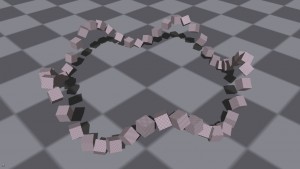Hello everyone,
I just set the prefix to OpenGL because thats in the end what my engine is based on. Tho the question is not related to OpenGL per se but of a general kind.
Currently i am rendering terrain using cubes. 'Calculating' the normals for the cube faces is fairly obvious but im running into some problems with the fact that a vertex basically has 3 normals. I am using a vertex buffer with the points of the cube and an index buffer which holds the indices for the faces. So a cube in the end consists of 8 vertices and up to 36 indices (depending on the neighbors). Now a vertex has 3 distinct normals and there should be no interpolation amongst the faces of the cube. Is there an elegant way to my normals working and avoiding to create 3 vertices for each point with lots of redundant data?
Thanks in advance for you help and a merry xmas
Plerion








